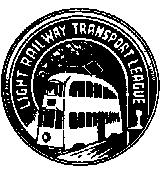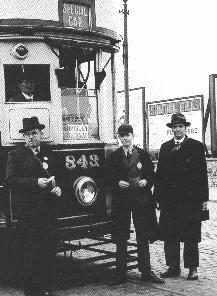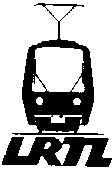Back in 1937 the Light Rail Transit Association came into being. It was not a very grand launch. A few persons, aroused by what they judged to be the folly of scrapping certain tram routes in North London, established contact with each other through the correspondence columns of local newspapers. After one or two tentative gatherings, an organising committee of three (George Jackman, Jay Fowler and Geoffrey Southerden) signalled the arrival of the new body, which was given the name Light Railway and Transport League by means of a press release to The Times and the technical press. Formation of the League had been a gradual process, and the committee assigned the purely arbitrary date 30 June 1937 to its establishment: a date not without its symbolism since it was the fourth anniversary of the disappearance of London County Council Tramways.
At that time, the prospects for tramways in the British Isles were hardly propitious. A Royal Commission had recently pronounced that tramways, if not obsolete, were at least obsolescent. Some 40 or so sizeable systems had already disappeared and even in the case of large cities, such as London, Birmingham, Manchester, Leeds and Bradford, there had been major route closures. Only a few systems offered evidence of modernisation: notably Glasgow, Liverpool, Leeds, Sunderland and Blackpool. Taking their cue from these, the organising committee in its prospectus gave as the League’s objectives:
To show transport in a proper perspective in which no type of vehicle is without its proper place…[and]…to foster interest in the light railway; and to help it to attain its rightful place, which it can only do if there is progressive development and a willingness on the part of transport authorities to adapt it to modern conditions.
Difficult though the position of the tramway industry was at that time, the new body, which had modified its title within a month to “Light Railway Transport League” was further burdened by internal dissent. It soon became apparent that among its few members there were two distinct schools of thought: one was concerned with studying the history and technical details of tramways as a matter of recreation and interest; the other favouring a proselytising approach, actively propounding the merits of modern tramways. The immediate effect of this disagreement was to stultify development of the new body in its crucial early stages. But on 24 November 1937 matters were brought to a head at a meeting conducted in a highly charged atmosphere. On a vote, carried by a majority of three to one, those present at the meeting resolved to opt for the active, propagandist, approach.

George Jackman, who headed those taking the minority view, did not accept the validity of the vote but eventually he and the others left the organisation and went on in January 1938 to establish the “Tramway & Light Railway Society”. At first the two bodies were bitter rivals, but with the passing years amicable relations were established and they now work harmoniously together through the medium of the Tramway Liaison Committee.
The majority faction, headed by Jay Fowler, with a new-found unity of purpose, could now concentrate on developing the League. Within a short time three major initiatives were undertaken. In January 1938 the first issue of a monthly magazine, entitled The Modern Tramway made its appearance. Even the name conveyed a challenging message. Although the first issue had only four pages and was unillustrated, the magazine was quickly and progressively improved. Its publication owed much to Fowler, who was a master printer. His office and works were at 245 Cricklewood Broadway, London NW 2, and this address became, and remained for many years, the head office of the League.
The second initiative was to set up an area structure. Hitherto most of the administration had been London-based, but by the close of 1938 new “provincial centres” had been established for Liverpool and North-West England, Birmingham and District, Wales and Western England, Eire, Manchester and District, and Newcastle and Sunderland and District, each headed by an Area Representative. Gradually area organisation was extended to the whole of the British Isles.

The final early initiative was the arranging of special tours of tramway systems, a concept which the League pioneered. The first such tour took place in May 1938 and was truly spectacular, involving London Transport no. 1 (formerly Bluebird) on a 60-mile tour of the London system from Waltham Cross in the north to Purley in the south. This event achieved considerable publicity and attracted many new members. Another major tour took place in October 1938 over the Birmingham system, from Dudley to Rednal (travelling through three counties: Worcestershire, Staffordshire and Warwickshire). A notable tour in August of the succeeding year was a visit to Belgium and the Netherlands, which took in the Bruxelles conduit system and an international tram journey from Breskens to Knokke. The outbreak of war the following month put an end for the foreseeable future to further foreign travel, but tours continued to be organised in Great Britain during the early wartime period.

War brought many new challenges for a recently-established organisation: the departure of some officers to the forces while those remaining were heavily committed to duties on the “home front”. At least one of the meetings of the League’s governing body, the Council, had to be conducted in an air raid shelter. In one instance at least the war was helpful: Lionel Boylett and Jack Norris, when attempting to survey Vauxhall Bridge Road to determine whether loading islands and other improvements to assist the trams could be accommodated, were helped by a friendly policeman, who held up the traffic under the impression that they were engaged in ARP works! Restrictions on paper limited the size of The Modern Tramway, but no issue was missed. (The only issue to fail to appear occurred in March 1956 attributable to a printing strike.) Certain items were censored: a report of the doubling of a modest section of track in Leeds was thought to imperil national security, as was a trackwork advertisement featuring a layout in already-closed Walthamstow! Also despite paper controls, the first edition of the classic Great British Tramway Networks was published in July 1940, the first of many monographs published by the organisation.
With the return of peace, group visits to British systems were resumed with a victory tour of Southampton in July 1945. These tours took place with ever-increasing frequency and became noted social occasions. Others took on a more formal aspect as annual conventions. With the shrinkage of British systems, a growing number were directed towards overseas systems: first western Europe, then beyond the iron curtain until, with growing affluence and improved transport, the objective became other continents. The most impressive was a three-week tour of China in 1984, when participants from seven countries were able to visit every tram system there.
It will have been apparent from what has already been written that at no stage has the organisation confined its interest to developments at home. Growing contacts with other countries has led to affiliations with like-minded bodies elsewhere, beginning with our Dutch opposite numbers (the NVBS) in March 1939. Such affiliations now extend to organisations in six continents. The proportion of our own members resident overseas has also increased so that they now amount to about a third of the total. The coverage of overseas news in the magazine, a particular development of post-war years, has no doubt encouraged many overseas persons to join the organisation. By the same token, many of these selfsame members have become part of a global network of reporters providing the Editor with local news and other information.
In another respect, the content of the magazine was reduced. The two decades following the end of the war saw the progressive elimination of virtually all of the remaining British tramway systems. Rather than chronicle this dismal decline and features of a historical character, a policy decision was taken to confine The Modern Tramway to modern news and developments. To counter the gap thus opened up, in the autumn of 1950 a new magazine was introduced, The Tramway Review. This was, and continues to be, a quarterly publication, devoting itself to historical material and until very recently featuring only systems of the British Isles.

Another area of activity at this time prohibited from sullying the columns of The Modern Tramway was that of tramcar preservation, in the sense of preserving such vehicles for posterity. The League had already, in January 1949, acquired one such car, Southampton 45, as a result of a tour of that system the preceding August. The acquisition of other vehicles was in the offing and a Museum Committee of the League was set up to wrestle with these projects. It would have been useful for the Committee’s work to have been given some publicity and for funds to have been solicited by means of the magazine. Denied these facilities, the Committee was ultimately wound up and a separate body was established in November 1955 to carry on this work. This body was The Tramway Museum Society. The previous August, at the League convention in Blackpool, Southampton 45 was formally handed over to the embryonic TMS. Here again, after a somewhat tetchy relationship at the outset, good relations have prevailed, latterly through the operation of the Tramway Liaison Committee.
Another significant development occurred in December 1961, when the League entered into an agreement with Ian Allan Ltd for the joint publication of the magazine. Apart from enabling it to appear on the bookstalls, so advancing publicity for modern trams, it enabled several technical improvements to be effected. In due course colour photographs appeared, first on the cover and then inside too. The title underwent a bewildering number of re-baptisms: Modern Tramway & Light Railway Review, 1962 to 1973; Modern Tramway & Rapid Transit Review, 1974 to 1976; Modern Tramway & Light Rapid Transit,1977 to 1980; Modern Tramway & Light Rail Transit,1981 to 1991. From 1992 to the present the title has been Light Rail & Modern Tramway (See Note 2 below). These changes vividly reflect the changing terminology of the times and the aspirations of the publishers to capture the appropriate readership! In 1992, the magazine assumed its current page size.
A revised agreement with Ian Allan Ltd in March 1995 paved the way for the appointment of the present Editor, Howard Johnston, in a remunerated capacity. His immediate predecessor, Jack Wyse, had been editor since June 1967 and had produced a total of no fewer than 333 issues – a remarkable achievement for anyone but especially so for a person who for most of that time had had also to do a normal job of work! Reverting to the early post-war years, the decline in tramways proceeded inexorably. This did not come to pass without the League making considerable efforts to arrest that process. Tactics varied, from articles and correspondence in newspapers to approaches to senior local authority and transport industry representatives. An attempt was made in Parliament to get the inhibiting Tramways Act of 1870 repealed. There were some modest achievements: procuring with Crompton-Parkinson Ltd the display of modern traction and control equipment at the Festival of Britain in 1951 and contributing to the retention of the Laxey-Ramsey section of the Manx Electric in 1957. But in truth the ethos of the time was against trams and it would have required prodigious efforts, well beyond anything which the League could have mustered, to have reversed that process.
In November 1979 an entirely new constitution was adopted and with it the name of the organisation was changed to the Light Rail Transit Association, which of course remains its name. By then attitudes had changed and the Association was in the happy position of finding its beliefs fully vindicated. Within a year, the Tyne & Wear Metro had opened, to be successively followed by the Docklands Light Railway, Manchester Metrolink and Sheffield Supertram. Midland Metro and Croydon Tramlink are in course of construction. Projects are in an advanced stage in Leeds and Nottingham, while others are planned. But gratifying though these developments have been, can the Association claim any credit for this dramatic reversal of fortune?
The answer is perhaps best summed up in an editorial which commemorated our golden jubilee in 1987. This magazine then wrote:
The Association does not claim, of course, to have brought about this revolution by itself. Major factors: economic, environmental, political, psychological, demographic, have all been at work together with numerous lesser issues. But the Association can claim to have kept the torch alight throughout the dark years of tramway decline, unceasingly propagating the gospel. It is probably true to say that the Association has been more effective in indirect, rather than direct, terms. In particular, many of its members, imbued with its spirit, have gradually attained positions of responsibility in the transport field, both here and abroad, a process which has enabled the worth and potential of modern tramways to be more easily recognised, fostered and ultimately exploited.
The strength of our membership has recently been supplemented in a particularly significant respect. In January of this year, the Association broke fresh ground by creating the new, remunerated, post of Secretary General. To this position we have appointed Bob Tarr, an eminent figure in transport circles and one well versed in the problems of urban transport. It is of course our hope that much of benefit to the Association and its objectives will stem from this appointment. That after 60 years we can still be taking bold new initiatives of this kind demonstrates the continuing vitality of the Association. This induces a feeling of confidence that it will be well-equipped to rise to the many new challenges which will no doubt have to be confronted in the progress to our centenary and beyond.
Notes:
- Photo is of the LRTL tour of Birmingham tramways on 23 October 1938, with tour car 843 at Dudley. Jay Fowler is on the right with his son William. On the left is Wingate Bett, later Editor of The Modern Tramway.
- From January 1998 the magazine title is Tramways & Urban Transit.
- The Association celebrated its diamond anniversary at its Annual General Meeting weekend in Newcastle upon Tyne in October 1997 – see the party snaps from that occasion.
- Geoffrey Claydon, the author of this history, can be contacted by e-mail at Geoffrey.Claydon@lrta.org
